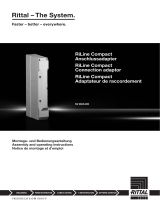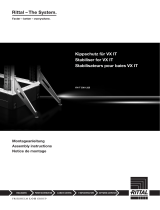Page is loading ...

CMC III Zahlencodeschloss
CMC III Coded Lock
Serrure à code chiffré CMC III
DK 7030.220
Installationsanleitung und Kurz-Bedienungsanleitung
Installation Guide and Short User’s Guide
Notice d'installation et notice d'utilisation succincte

Rittal CMC III Zahlencodeschloss / Coded Lock / Serrure à code chiffré 2
Abb./Fig./Fig. 4: Montage TS-Stahlblechtür / Assembly TS sheet steel door / Montage porte en tôle
d´acier TS
Abbildungen / Figures / Figures

Rittal CMC III Coded Lock 6
EN
1 Notes on documentation
This installation and short user's guide is intended for experienced trained specialists and contains only
the most important information concerning the assembly, installation and function of the CMC III Coded
Lock (subsequently called coded lock).
1.1 Associated documents
CMC III Coded Lock assembly, installation and user's guide.
It is available at www.rittal.com and contains the complete application-relevant information and techni-
cal data for the coded lock with regard to:
– Further assembly possibilities
–Functions
– Configuration possibilities
– Detailed operating instructions
– Troubleshooting
2 Safety instructions
– Assembly and installation of the coded lock may only be performed by experienced trained special-
ists.
– The coded lock housing must not be opened.
– The coded lock may not come in contact with water, aggressive or inflammable gases and vapours.
– The coded lock may only be operated within the specified environmental conditions (see Section 3.4).
3 Product description
3.1 Functional description
The coded lock is used to release enclosure or room doors when a numerical code is entered. The nu-
merical code is checked in the connected CMC III PU and, if validated, an appropriate door release in-
itiated. The coded lock has an identification that allows it to be detected automatically by the
CMC III PU.
3.2 Proper use
The CMC III Coded Lock is used only for the door release when a numerical code is entered. It may be
used only together with the CMC III PU and the CAN bus access. Any other use is not permitted.
3.3 Scope of delivery
– CMC III Coded Lock
– Provided accessories (see Fig. 1)
– Installation and Short User's Guide
3.4 Operating conditions
The coded lock may only be operated under the following operating conditions:
Temperature operational range: +0°C to +55°C
Humidity operational range: 5% to 95% relative humidity, non-condensing
Degree of protection: IP30 in accordance with EN 60 529
Notes on documentation, Safety instructions, Product description
EN

EN
7 Rittal CMC III Coded Lock
4Assembly
4.1 Assembly instructions
The assembly of the coded lock is made as shown in Fig. 3 or Fig. 4.
5 Installation and operation
5.1 Operating and display elements
The operating and display elements are shown in Fig. 2.
Key for Fig. 2
1Numeric keys 0-9
2"Enter" key
3Red LED
4Green LED
5"C" key
5.2 Installation
• First disconnect the CAN bus at the CAN bus access.
• Attach the appropriate handle to the door to be monitored.
• Connect this handle with the connection cable to the CAN bus access.
• Connect the coded lock with the connection cable to the CAN bus access.
• Reconnect the CAN bus to the CAN bus access.
Display of the status change:
– The two green and the two red CAN bus LEDs on the CAN bus connection of the CAN bus access
flash.
– The multi-LED of the Processing Unit flashes continually in the green – orange – red sequence.
– The multi-LED of the CAN bus access flashes blue continuously.
• Press the "C" key on the CMC III PU (a first audio signal is issued) and keep it pressed for approx.
3 seconds until a second audio signal is issued.
Display of the status change on the CAN bus LEDs of the CAN bus access:
– Green LEDs light continuously: CAN bus status "OK".
– Red LEDs light continuously: CAN bus status faulty.
Display of the status change on the multi-LED of the Processing Unit.
– Continuous green light: All units attached to the CAN bus have the "OK" status.
– Continuous orange light: At least one unit attached to the CAN bus has the "warning" status.
– Continuous red light: At least one unit attached to the CAN bus has the "alarm" status.
Display of the status change at the green LED of the coded lock (Fig. 2, Pos. 4):
– Green LED: Flash in regular intervals (approx. 5-10 seconds).
If the installation is not successful: see Section 1.1.
Assembly, Installation and operation

Rittal CMC III Coded Lock 8
EN
5.3 Settings
By default, the 1001, 1002 and 1003 access codes have access authorisation for the handle installed
on the CMC III CAN bus access. The access authorisation is changed in the access.cmc3 file. After
the first access attempt, this file is contained in the upload folder on the CMC III Processing Unit. It can
be downloaded with FTP and then changed with an editor.
Further information concerning this topic is contained in the main guide at www.rittal.com (see
Section 1.1).
In a later update, it is planned to integrate the configuration of the access authorisations on the Web
user interface.
• Enter an authorised access code.
The green LED lights continually for approx. 2 seconds (Fig. 2, Pos. 4).
• Enter an unauthorised access code.
The red LED lights continually for approx. 2 seconds (Fig. 2, Pos. 3).
To determine whether any software updates are required: see www.rittal.com or contact Rittal Service
(see Section 6).
6 Service
For technical questions, please contact:
Tel.: +49 (0) 2772/505-9052
E-mail: [email protected]
Homepage: www.rittal.com
For complaints or service requests, please contact:
Tel.: +49 (0) 2772/505-1855
E-mail: [email protected]
Service

Enclosures
Power Distribution
Climate Control
IT Infrastructure
Software & Services
1. Aufl. 06.2011 / Id.-Nr. A45104 01 IT75
RITTAL GmbH & Co. KG
Postfach 1662 y D-35726 Herborn
Phone +49(0)2772 505-0 y Fax +49(0)2772 505-2319
E-mail: info@rittal.de y www.rittal.com
/

